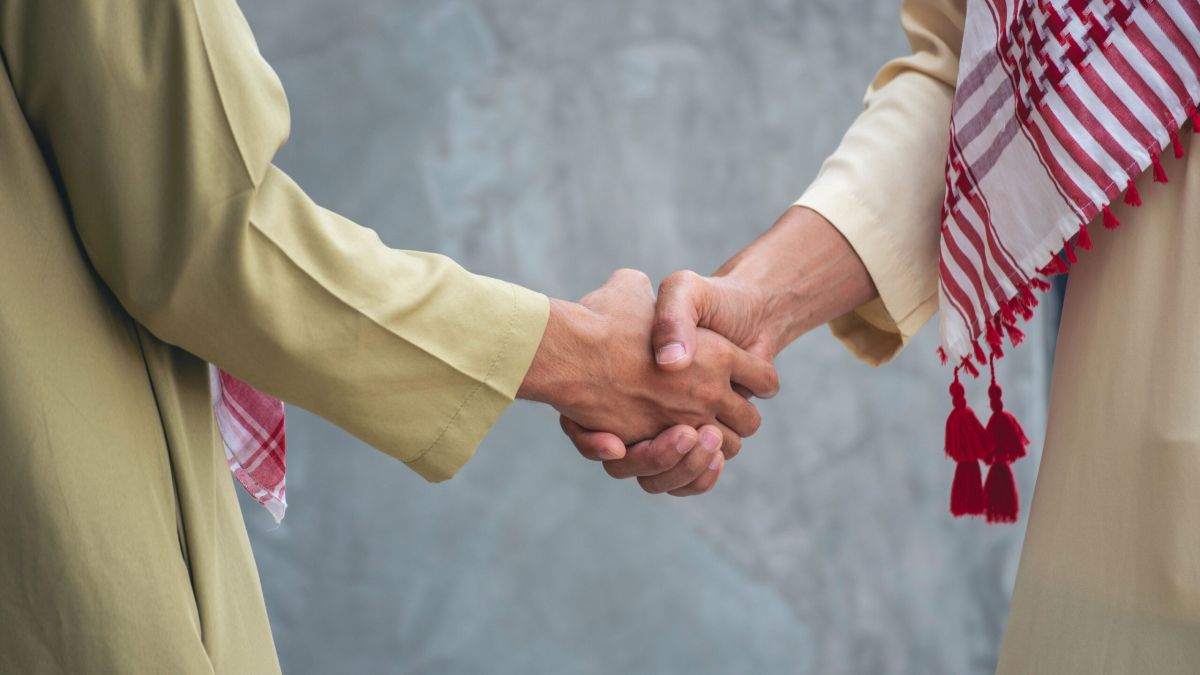Dressing ‘Professionally’ and Guidance Regarding Resembling the Attire of the Disbelievers
Al-ʿAllāmah ʿAbd al-Muḥsin al-ʿAbbād, Imām Muḥammad Nāṣir al-Din al-Albānī, Imām Muḥammad ibn Ṣāliḥ al-ʿUthaymīn
Dressing ‘Professionally’ and Guidance Regarding Resembling the Attire of the Disbelievers
Al-ʿAllāmah ʿAbd al-Muḥsin al-ʿAbbād, Imām Muḥammad Nāṣir al-Din al-Albānī, Imām Muḥammad ibn Ṣāliḥ al-ʿUthaymīn


[Q]: There are Islamic students that were once advised to avoid wearing trousers. In response, they began mocking the thawb1, claiming that wearing it represents a form of resembling women.
[A]: The thawb (or loose garment) is worn by both men and women, although the type of garment for each obviously differs from one another such that men and women have their own form of the garment
As for wearing trousers (as an outer garment), this was brought to us by the disbelievers. Fundamentally, it is a foreign import (from their counterparts) that has become commonplace amongst the Muslims now. It is not a Muslim garment. Although, if a person must wear it because he resides, for example, in a country where this is the norm, then let him ensure that his trousers are tailored in a loose fashion, unconstricted, such that the shapes and sizes of his limbs are not easily discernible.2
Al-ʿAllāmah ʿAbd al-Muḥsin al-ʿAbbād
[Q]: What is the ruling on wearing trousers?
[A]: Wearing trousers is among the catastrophes that have plagued modern Muslims, a habit whose impetus stems from the ideological conquest of the Muslims by the disbelievers which has facilitated the inappropriate exposure of Muslims to their habits and customs, leading eventually to their incorporation and imitation of these disbelievers. To the extent that some Muslims will even defend and support it. This subject is deserving of great elaboration, but I will summarise my answer here. Wearing trousers constitutes two magnanimous societal ills:
- It may display the shapes of one’s private parts (and hips), especially when people pray wearing them without donning a long shirt that covers their hips. Moreover, what is between their buttocks may even be seen when they perform the sujūd wearing them! This is—unfortunately—well-observed and acknowledged, specifically apparent in congregational prayer wherein a man is praying behind another man who is wearing trousers, fully able to see the two halves of his thighs or even that which is more revealing than that! This is the first societal ill: Wearing trousers facilitates the displaying of one’s private parts and, as such, should not be worn by any man or, even more deservedly, woman. Just as they should generally avoid any other garment that similarly facilitates the displaying of their private parts. I have further elaborated on this point in my book Jilbāb al-Marʾat al-Muslimah.
- Trousers are among the hallmark garments of the disbelievers. For there has never been a single time period—in all the many past generations of Muslims—wherein they took wearing trousers as a valid custom. The Prophet (صلى الله عليه وسلم) said: “Whoever seeks resemblance to a people is considered from among them”3. It was also narrated in Ṣaḥīḥ Muslim that a man once came to the Prophet (صلى الله عليه وسلم) and—after greeting him with the salām—he (صلى الله عليه وسلم) said in reference to his clothing: “This is among the clothing worn by the disbelievers, so refrain from wearing it”.
In consideration of this, I advise all Muslims who have been tested by Allāh with wearing trousers to, at the very least, wear them with a long overgarment that covers them; that is, in a similar fashion to some of our Pakistani and Indian brethren who wear a long jacket (khamīs) over it that reaches their knees. In actuality, this is a measure that may be utilised by Muslim men to somewhat lessen the audaciousness attributable to the display of one’s private parts that is inextricably linked to wearing trousers.4
For it seems like a daily occurrence that some new fashion is brought before us. Most recently, people have begun wearing these trousers called Charleston or Jakam or some such strange name (i.e. fashion trend of the day), its top portion is tight and constricting while the bottom is cut wide; wider even than the sirwāl (wide-legged variant of trousers ordinarily worn underneath the thawb). Regarding this, I say: Glory be to Allāh! This is nought but the playful mockery of Shayṭān with a person’s offspring. A Muslim should be protective of his Islamic identity, constantly maintaining and endeavouring to establish it. For, if a Muslim was to board a helicopter and be transported to France, when he comes out the French people there should recognise him as a Muslim because his manner of dressing should differ from them. Where is this today?! Even the Muslim communities that used to possess an easily identifiable, well-known manner of dressing like the Saudis will board a plane and, all of a sudden, their entire wardrobe changes. Like this person has changed from an Arab to a Frenchman; suddenly wearing a tie, removing the shimāgh and ʿiqāl (gulf headdress), appearing with a bare head exactly like a non-Arab. This is an indication that, more than anything else, Muslims no longer derive power or strength from ascribing themselves to this religion. This is the catastrophe of this age. I implore the Muslims to re-examine the reality of their circumstance and return to enacting the legislation of their Lord. For there shall never be safety for them until they return to Islām, as authentically narrated in the ḥadīth: “If you begin trading using al-ʿīnah5, closely adhering to the tails of cows6, deriving pleasure from the harvest, and abandoning jihād in the way of Allāh [by striving against one’s own false desires and against the enemies of Allāh at its appropriate time], then Allāh shall subjugate you to humiliation. And He shall never remove it from you until you return to your religion”.7
Thus, we ask Allāh to instil within us correct, sound guidance. We ask Him to grant us knowledge of the religion of our Lord, and to inspire within us the implementation of what we have learned.8
Allāh—the Exalted in Might—described the true believers saying:
إِن تَنصُرُوا اللَّهَ يَنصُرْكُمْ
“If you help (in the cause of) Allāh, He will help you”
(Muḥammad 47:7)
Therefore, it is from īmān to help the cause of Allāh. We know that this helping by the Muslims (or the believers) is not with strength or might, it is by means of īmān and following Allāh’s revelation. The Muslims today are great in number, but the true believers among them are scant.
Regarding the claim that if the Prophet (صلى الله عليه وسلم) was alive today he would wear trousers and a tie—that is, he would seek resemblance to the disbelievers, in which we responded with the ḥadīth “Whoever seeks resemblance to a people is considered among them” and many other narrations with the same meaning, there are those who allege that this represents a banal superficiality that is trivial and an objection that is impermissible. Not that this objection is not recommended; they claim that we must not busy ourselves with this issue at all. Then, they further deduce from the claim that dressing in this way is permissible, claiming what is more vile and dangerous, which is that if the Prophet (صلى الله عليه وسلم) was living among them, he would dress in this way. That is, he would don the outfit of a Frenchman, completing the look by tying a tie which itself has no benefit except for the actualisation and thorough facilitation of resembling the disbelievers. As we may acquiesce that one may manage to cover his private area with trousers—even those that are tight—and that wearing a suit jacket offers protection from the cold. As for this tie, it has no functional benefit except for resembling the outfits of the Frenchman disbeliever. If one was to claim that the Prophet (صلى الله عليه وسلم) would have seen wearing suit jackets permissible, we would say ‘perhaps’ [due to the protection from the cold derived from it]. As for this tie, it should act as an indication of the extremely great distance the people of today have put between themselves and the Sunnah of the Messenger (صلى الله عليه وسلم). The Muslims of today shall never be saved from their pitiful, shameful state except by purification from such habits, and by proper teaching and education such that they are fully aware of the Sunnah of the Messenger (صلى الله عليه وسلم), his creed, behaviour and manners, the matters of wājibāt (obligation), that which is mustaḥabbāt (recommended), and mubāhāt (permissible). Without such knowledge, the Muslims shall never attain safety, in spite of their screaming and moaning over the spilt blood of their brethren that has, today been spilt cheaply, they shall never derive benefit from their incessant complaints until they return to the Sunnah.
The impetus for the claim made here is that this person learnt a single piece of evidence and immediately thought that he completely encompassed the entire issue. The evidence used to support this claim is the authentic ḥadīth in Ṣaḥīḥ al-Bukhārī in which the Prophet (صلى الله عليه وسلم) once wore a narrow-sleeved, Roman garment. In consideration of this, they say: “Here he (صلى الله عليه وسلم) donned clothing worn by the disbelievers! So why then do you prevent us from wearing their clothing so strictly?” This claim is made by a person who is completely ignorant of Islamic fiqh. It is as if he believes that we—callers to the Book of Allāh, the Sunnah of His Messenger (صلى الله عليه وسلم) and the methodology of the pious predecessors—espouse the position that any piece of clothing that comes to us from the disbelievers is impermissible. For this reason, some of the more foolish, moronic among them will, in an attempt to refute us, say: “Do you not drive cars imported from the unbelieving countries? Do you not wear their shoes and socks?” and the likeness of such statements. The reason for this is that they are unable to differentiate between religious and worldly innovations. It is this lack of differentiation that has caused them to open the door to religious innovation using the permissibility of worldly innovations as a justification.
In this same way, they conclude that every single invention or product made by the disbelievers must be impermissible without any manner of discernment. There are two discerning factors that should be employed here and it is my belief that—at the very least—every student of Islamic knowledge should be well-aware of these two guiding principles:
- Practices and products from the disbelievers which are considered among their distinguishing, identifiable features are impermissible for the Muslim to attain and use. This is the variety of their exports that we have been cautioned regarding, which falls under the aforementioned ḥadīth “Whoever seeks resemblance to a people is considered among them”.
- That which is from them but is not considered among their distinguishing features, but it is well within our abilities as Muslims to act contrary to them, then we should seek to oppose them. This opposition is not simply to avoid resemblance to them, but to actively show our opposition to their way.
Regarding this subject, there is a magnanimous ḥadīth whose importance is not often widely acknowledged: “Indeed, the Jews and Christians do not dye their [white] hair, so act contrary to them”. That is, showing contrariness to them is one matter, and abandonment of resemblance to them is another. Contemplate with me this ḥadīth: “Indeed, the Jews and Christians do not dye their [white] hair”; that is, their hair that has, unwillingly and against their own will, turned white. This change of colour is not their own doing but from among the decrees of their Creator, regarding which the Muslim and the disbeliever are the same. As the hair of anyone who reaches a certain age will turn white regardless of their state of belief. Despite this, the Messenger of Allāh (صلى الله عليه وسلم) directs us to “act contrary to them” by enacting the command to “dye your hair”. Therefore, merely seeking to be different to them is a legislative goal of great importance.9
Imām Muḥammad Nāṣir al-Dīn al-Albānī
[Q]: What is the ruling on a man wearing trousers that do not rest below his ankles?
[A]: There is nothing wrong with this provided he lives among people who are similarly wearing trousers and he does not allow them to sit below his ankles. If, however, he lives in a community of people that are not accustomed to wearing them, he should avoid it. This is because, in this instance, wearing them would be considered a form of clothing worn to seek attention (libās shuhrah) which is ḥarām.
My son! I advise you to avoid them completely. The qamīṣ (long shirt that covers the upper and most of the lower body) is a more encompassing means of covering yourself, while also being milder and more masculine. Trousers are much more constricting, they expose you when performing sujūd, or when trying to sit comfortably. Also, what benefit do you seek from wearing them?
As for those who work as mechanics or have adopted a similar profession that requires their clothing be closely adhered to their body, they may be excused for dressing in this way. As for the other professions besides them, all glory be to Allāh! How can we abandon our clothing within which we are able to move so freely, which was also the same manner of dressing that was adopted by our forefathers, and instead dress in a completely new, foreign way?! This is a great issue!
Be well-aware that imitation of the non-Muslims has a great effect upon the heart of the imitator. For this reason, the Prophet (صلى الله عليه وسلم) said: “Whoever seeks resemblance to a people is considered among them”. The scholars say: This is because the one who attempts to resemble them outwardly will start to become accustomed to their mannerisms and way of dress to the extent that he finds his heart loving them as well. Until, finally, he begins to seek resemblance to them with regards to their creed and beliefs—we seek refuge in Allāh—as he (صلى الله عليه وسلم) said he will be “considered among them”. Thus, we do not say he is considered among them in only his manner of dressing. Rather, he is considered among them in his manner of dressing and it is only a matter of time until the germs of this resemblance infect his creed and beliefs as well.10
Imām Muḥammad ibn Ṣāliḥ al-ʿUthaymīn
Endnotes:
[1] Translator note: The word ‘thawb’ refers to the long shirt that covers the upper and lower parts of the body worn in countries like Saudi Arabia and other Arabian Gulf countries.
[2] Source: Sharḥ Sunnan Abī Dāwūd 40:464.
[3] Authentic: narrated by Abū Dāwūd: 4031 and graded authentic by Shaykh al-Albānī in Ghāyat al-Marām: 109.
[4] Source: Jāmiʿ Turāth al-ʿAllāmah al-Albānī 7:304-305.
[5] ʿĪnah: type of usurious transaction where the buyer and seller use a commodity that meaninglessy changes hands in an attempt to disguise usury.
[6] Adhering to the tails of cows: discovering new methods of farming and agriculture, adhering to them so obsessively and attentively that one abandons striving in Allāh’s cause.
[7] Authentic: narrated by Abu Dāwūd: 3462 and graded authentic by Shaykh al-Albānī as mentioned here and by Shaykh ʿAbd al-Muḥsin al-ʿAbbād in Sharḥ Sunan Abī Dāwūd 9:395.
[8] Source: Jāmiʿ Turāth al-ʿAllāmah al-Albānī 7:292
[9] Source: Jāmiʿ Turāth al-ʿAllāmah al-Albānī 9:85-87
[10] Source: Liqāʾ al-Bāb al-Maftūḥ 23:235.
Translated by: Riyāḍ al-Kanadī
⚠️ Donate to the Yearly Digital Daʿwah Sponsorship Drive – $20,000 Target
Become a sponsoring publisher of free islamic content.
Most Popular: Last 30 Days

The Difference Between Ghusl (Ritualistic Shower) to Remove Janābah (impurity) and a Common Shower

The Prohibition of Putting Oneself Ahead of Allāh and His Messenger (ﷺ)









